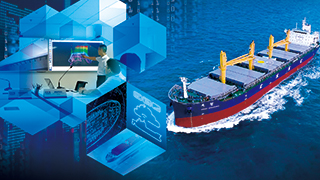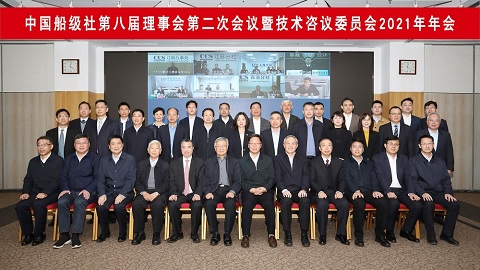By Xiang Linhao, CCS Science & Technology Innovation and Test Center

With the accelerated development of intelligent manufacturing, intelligent ships and intelligent shipping, the industry is accelerating the pace of digital transformation . New technologies have brought a significant influence to the operation and service modes of ship survey . Digital development oriented to industrial customer demands and service objects has promoted the survey mode transforming from “traditional on-site survey” to “real-time remote, digital survey” gradually .
1. China Classification Society's research on digital ship survey technologies
In 2019, China Classification Society (CCS) started implementing remote ship survey, which is applicable to temporary survey items such as documents and data, damage and repair, removal of ship class conditions, validity extension,turbine cycle survey, and change of shipowner or ship name .
In 2020, to avoid the impact of the pandemic on ship survey, review and certificate validity, CCS performed research and application of key technologies of real-time remote ship survey oriented to annual survey . It proposed series of technical solutions such as confined ship space communication by“5G/4G/VSAT+Ad-Hoc Network”, self-adaptive compression and low-delay transmission of high-throughput survey data under complex communication conditions, multi-terminal data acquisition and cooperative interaction control for remote ship survey, remote survey by “5G+unmanned aerial vehicles” for confined ship cabins, and scenario-type remote
ship survey platform, to achieve rapid networking and high-quality communication under complex environments, and remote survey by close observation of internal structures of confined ship space based on unmanned aerial vehicles, solve ship-shore interaction difficulties faced by remote ship survey,create a new mode of remote ship survey based on ship-shore cooperation, and apply it in remote survey of ships engaged on international voyages, ocean-going fishing vessels, and vessels
engaged on domestic voyages .
In 2021, CCS submitted the following proposals to the International Maritime Organization, i .e . “Suggestions on Analyzing the Framework of Remote Survey Work and Developing Technical Requirements” and “Introduction to Application of New Technologies in Remote Ship Survey”,which were adopted .
2. Development modes of digital ship survey
Remote survey can be classified into the following three modes . 1. Remote survey within a limited range based on photos, video documents or instant messaging software:A ship surveyor remotely confirms the compliance of inspected items through photos acquired from the ship, video documents or real-time audio and video communication . 2.Remote survey within a larger range through real-time audio and video communication with professional hardware and software equipment based on such solutions as “network communication, acquisition terminals, survey platforms, and ship-shore collaboration” . 3. Remote survey based on data:
With development of ship digitalization and intelligentization,it is to comprehensively utilize online monitoring, data analysis,status evaluation, intelligent diagnosis, risk analysis and other technologies to perform digital survey and verification on the conditions of ship structure, equipment and system operation within the applicable range .
3. Main concerns of digital ship survey
With the development of digital and intelligent technologies, remote survey will develop from the mode of“remote witness” with audio and video information to “remote survey based on data” (digital survey) with ship status data,transform from the experience-driven survey mode to data-driven digital survey mode, and transform from regular survey to on-condition survey based on status monitoring . During implementation of the digital survey, attention should be paid to the following aspects:
1. Data sources: Besides document materials,photos, video documents and real -time audio and video communication, the data acquisition modes for remote
survey based on data also include: monitoring data acquired by sensors, measurement data and test records stored in the management system, image and/or measurement data acquired by unmanned aerial vehicles/robots/intelligent wearable equipment/portable measuring equipment, etc .
2. Data quality: High-quality data is the basis of digital survey . CCS’s Guidelines for Quality Assessment of Ship Data classifies data quality into three types, i .e . syntactic quality, semantic quality and pragmatic quality, and defines the data quality model from 15 aspects including “correctness,completeness, consistency, certainty, currency, accessibility,compliance, confidence, efficiency, accuracy, traceability,intelligibility, availability, transportability and restorability”through two perspectives, i .e . inherent data quality and system-dependent data quality .
3. Data identification and exchange: Data used for digital survey generally comes from related information-based and digital systems deployed on ships . Under the authorization of ship companies, related data is sent from the ship-based or shore-based system to CCS . Due to various types of shipboard equipment and systems, the data identification, data acquisition methods and plans, data storage, data integration, interface protocols, transmission protocols, exchange formats and
communication requirements need to be implemented by the ship companies according to unified standards agreed with CCS .
4. Implementation of digital survey: Establishment of current technical requirements (conventions, regulations and rules) related to ship survey is mostly driven by experience . The survey requirements prepared by CCS are also implemented from aspects such as routine document and record check, visual check, close observation, functional testing, consistency check,and operation verification basically .

Data-driven digital survey has essential differences from traditional survey modes . On one hand, the traditional survey modes cannot be achieved fully by digital means; on the other hand, digital survey is established on the data-driven basis, i .e .judging the health conditions of ships based on data, so it has essential differences from traditional survey in both criteria formulation and execution mode .
Analysis on technical requirements, survey requirements and survey modes is necessary for digital survey . On one hand,it is to comprehensively utilize the monitoring data acquired by sensors, measurement data and test records stored in the management system, as well as images and measurement data acquired by various means and equipment, and establish survey/verification criteria and verification/evaluation models,to judge the health conditions of ships based on their historical
operation/monitoring data analysis; on the other hand, it is to adopt the combined mode of data driving and mechanism modeling, to judge the health conditions of ships based on such technologies as online monitoring, machine learning, data analysis, and risk analysis .
Fully achieving digital survey of ships also needs coordinated development of technologies, conventions,regulations and rules, as well as formation of the data sharing and co-governance ecology of various industrial parties . At the present stage, digital survey has been applied successfully in a part of equipment or systems . The data-driven digital survey mode will become the development direction of ship survey in the future .
Note: If you need to reprint, please indicate the source of the information.













